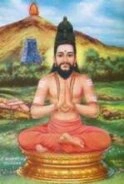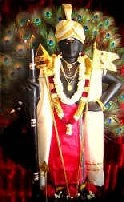

திரு அருணகிரிநாதர் அருளிய
திருப்புகழ்
Sri AruNagirinAthar's
Thiruppugazh

 |  திரு அருணகிரிநாதர் அருளிய Sri AruNagirinAthar's |  |
|---|
| (இந்த வலைத்தளத்தைப் பயன்படுத்துவதற்கு முன்பு எனது முக்கியக் குறிப்பைப் படியுங்கள் - நன்றி). (Please read my important note before using this website - Thank You). |
| திருப்புகழ் 744 பலபல தத்துவம் (திருவெண்ணெய்நல்லூர்) Thiruppugazh 744 palapalathaththuvam (thiruveNNeynallUr) |
 |  | தமிழிலும் ஆங்கிலத்திலும் பொருள் எழுதியது ஸ்ரீ கோபால சுந்தரம் Meanings in Tamil and English by Sri Gopala Sundaram | English PDF அமைப்பு in PDF | ஆலய வரிசை அகரவரிசை எண்வரிசை தேடல் venue list alphabetical numerical search |
|
தனதன தத்தன தனதன தத்தன தனதன தத்தன தனதன தத்தன தனதன தத்தன தனதன தத்தன ...... தனதான ......... பாடல் ......... பலபல தத்துவ மதனையெ ரித்திருள் பரையர ணப்படர் வடவன லுக்கிரை படநட நச்சுடர் பெருவெளி யிற்கொள ...... விடமேவிப் பவனமொ ழித்திரு வழியைய டைத்தொரு பருதிவ ழிப்பட விடல்கக னத்தொடு பவுரிகொ ளச்சிவ மயமென முற்றிய ...... பரமூடே கலகலெ னக்கழல் பரிபுர பொற்பத வொலிமலி யத்திரு நடனமி யற்றிய கனகச பைக்குளி லுருகிநி றைக்கட ...... லதில்மூழ்கிக் கவுரிமி னற்சடை யரனொடு நித்தமொ டனகச கத்துவம் வருதலு மிப்படி கழியந லக்கினி நிறமென விற்றுட ...... லருள்வாயே புலையர்பொ டித்தளும் அமணரு டற்களை நிரையில்க ழுக்களி லுறவிடு சித்திர புலவனெ னச்சில விருதுப டைத்திடு ...... மிளையோனே புனமலை யிற்குற மகளய லுற்றொரு கிழவனெ னச்சுனை தனிலவ ளைப்புய புளகித முற்றிபம் வரவணை யப்புணர் ...... மணிமார்பா மலைசிலை பற்றிய கடவுளி டத்துறை கிழவிய றச்சுக குமரித கப்பனை மழுகொடு வெட்டிய நிமலிகை பெற்றருள் ...... முருகோனே மகிழ்பெணை யிற்கரை பொழில்முகில் சுற்றிய திருவெணெய் நற்பதி புகழ்பெற அற்புத மயிலின்மி சைக்கொடு திருநட மிட்டுறை ...... பெருமாளே. ......... சொல் விளக்கம் ......... பலபல தத்துவம் அதனை எரித்து இருள் பரை அரணப் படர் வட அனலுக்கு இரை பட ... பலபல தத்துவ சேஷ்டைகளையும், அஞ்ஞான இருளையும் எரித்து, சிவசக்தியே காவலாக துக்கங்களை வடவா முகாக்கினிக்கு இரையாகும்படி ஆக்கி, நடநச் சுடர் பெரு வெளியில் கொ(ள்)ள இடம் மேவி பவனம் ஒழித்து இரு வழியை அடைத்து ... நடன ஜோதியை பரந்த ஆகாச வெளியில் கண்டு கொள்ளும்படியாக (விந்து நாதம் கூடும்) முகப்பில் சேர்ந்து, வாயுவை அடக்கி, இடகலை, பிங்கலை* என்ற இரண்டு வழிகளையும் மாற்றி அடைத்து, ஒரு பருதி வழிப் படவிடல் ககனத்தொடு பவுரி கொ(ள்)ளச் சிவமயம் என முற்றிய பரம் ஊடே ... ஒப்பற்ற சூரிய ஜோதியின் பிரகாச நிலையில் அமைந்து, ஆகாய வெளியில் நடனம் கொள்ள சிவ மயமாய் முற்றும் பரந்த பர வெளியில், கலகல எனக் கழல் பரிபுர(ம்) பொன் பத ஒலி மலியத் திரு நடனம் இயற்றிய கனக சபைக்குளில் உருகி நிறைக் கடல் அதில் மூழ்கி ... கலகல என்று கழலுகின்ற சிலம்பும் அழகிய திருவடியின் ஒலி நிரம்ப, திரு நடனம் புரிந்த பொன் அம்பலத்தில் உருகி, நிறைந்த சுகானந்தக் கடலில் முழுகி, கவுரி மின்னல் சடை அரனொடு நித்தமொடு அனக சகத்துவம் வருதலும் இப்படி கழிய நலக்கு இனி நிறம் என் நவிற்று உடல் அருள்வாயே ... பார்வதி தேவி மின்னலை ஒத்த சடையையுடைய சிவபெருமான் ஆகியவரோடு தினந்தோறும் குற்றமற்ற உலக தத்துவமே நீயாகத் தோன்றும் நிலை வந்து கூடவும், இவ்வாறு கழியும்படியான நன்மையால், இனி புகழொளி எனக் கூறப்படும் உடலை எனக்குத் தந்தருளுக. புலையர் பொடித்தளும் அமணர் உடல்களை நிரையில் கழுக்களில் உற விடு சித்திர புலவன் எனச் சில விருது படைத்திடும் இளையோனே ... இழிந்தவர்களும், திருநீற்றை விலக்கித் தள்ளுபவர்களும் ஆகிய சமணர்களின் உடல்களை கழு முனை வரிசைகளில் பொருந்தவிட்டவனும், சித்திரக் கவி பாடவல்ல புலமை கொண்டவன் என்று சில வெற்றிச் சின்னங்களைப் பெற்றவனுமாகிய (திருஞானசம்பந்தர் என்னும்) இளையவனே, புன மலையில் குற மகள் அயல் உற்று ஒரு கிழவன் எனச் சுனை தனில் அவள் ஐப் புய(ம்) புளகிதம் உற்று இபம் வர அணையப் புணர் மணி மார்பா ... தினைப் புனம் உள்ள வள்ளி மலையில் குறப் பெண் வள்ளியின் பக்கத்தில் சென்று, ஒரு கிழவன் என வேடம் பூண்டு, சுனையில் அவளுடைய அழகிய புயத்தை புளகாங்கிதத்துடன், யானை வந்து எதிர்ப்பட, தழுவிப் புணர்ந்த அழகிய மார்பனே, மலை சிலை பற்றிய கடவுள் இடத்து உறை கிழவி அறச் சுக குமரி தகப்பனை மழு கொ(ண்)டு வெட்டிய நிமலிகை பெற்று அருள் முருகோனே ... மேரு மலையை வில்லாகப் பிடித்த சிவபெருமானது இடது பாகத்தில் இருக்கின்ற உரிமை வாய்ந்தவள், தருமமே புரியும் சுக குமரி, பிதாவாகிய தக்ஷனை மழுவைக் கொண்டு வெட்டிய தூய்மையானவள் ஆகிய (தாக்ஷாயாணி என்ற) உமாதேவி பெற்றருளிய முருகோனே, மகிழ் பெ(ண்)ணையில் கரை பொழில் முகில் சுற்றிய திருவெ(ண்)ணெய் நல் பதி புகழ் பெற அற்புத மயிலின் மிசைக் கொடு திரு நடம் இட்டு உறை பெருமாளே. ... மகிழ்ச்சி தரும் பெண்ணையாற்றின் கரையில், சோலையும் மேகங்களும் சூழ்ந்த திருவெண்ணெய்நல்லூர்** என்னும் நல்ல ஊரில், புகழ் விளங்க அற்புதமான மயிலின் மீது வீற்றிருந்து திரு நடனம் புரிந்து விளங்கும் பெருமாளே. |
* இங்கு சிவயோக முறைகள் விளக்கப்பட்டுள்ளன. அதன் சுருக்கம் வருமாறு: நாம் உள்ளுக்கு இழுக்கும் காற்றுக்குப் 'பூரகம்' என்றும், வெளிவிடும் காற்றுக்கு 'ரேசகம்' என்றும் பெயர். உள்ளே நிறுத்திவைக்கப்படும் காற்றுக்கு 'கும்பகம்' என்று பெயர். உட் கொள்ளும் பிராணவாயு உடலில் குறிப்பிட்ட 'ஆதாரங்கள்' (நிலைகள், சக்கரங்கள்) மூலமாகப் படிப்படியாகப் பரவி, மேல் நோக்கிச் சென்று, தலையில் 'பிரம கபால'த்தில் உள்ள 'ஸஹஸ்ராரம்' (பிந்து சக்கரம்) என்ற சக்கரத்துக்குச் செல்லும். இந்த ஐக்கியம் ஏற்படும்போது, அமுத சக்தி பிறந்து, ஆறு ஆதாரங்களுக்கும் ஊட்டப்பட்டு, மீண்டும் அதே வழியில் 'மூலாதார'த்தை வந்து அடையும். இந்த ஆதாரங்களை ஒழுங்கு படுத்தும் வகையில் மூன்று 'மண்டல'ங்களும் (அக்கினி, ஆதித்த, சந்திர மண்டலங்கள்), பத்து 'நாடி'களும் (இடைகலை, பிங்கலை, சுழுமுனை முதலியன) உள்ளன. 'இடைகலை' பத்து நாடிகளுள் ஒன்று. இடது நாசியால் விடும் சுவாசம். 'பிங்கலை' பத்து நாடிகளுள் ஒன்று. வலது நாசி வழியால் விடும் சுவாசம். 'சுழு முனை' இடைகலைக்கும் பிங்கலைக்கும் இடையில் உள்ளது. 'சுழு முனை' ஆதாரம் ஆறிலும் ஊடுருவி நிற்பது. 'இடைகலை'யும், 'பிங்கலை'யும் ஒன்றுக்கொன்று பின்னி நிற்பன. சுவாச நடப்பை 'ப்ராணாயாமம்' என்ற யோக வன்மையால் கட்டுப்படுத்தினால் மன அமைதி ஏற்படும். |
** திருவெண்ணெய்நல்லூர் சாலை ரயில் நிலையத்துக்கு வடக்கே 4 மைலிலும், பண்ணுருட்டிக்கு மேற்கே 15 மைலிலும் உள்ளது. |
| 'wikisource' reference links for this song இப்பாடலுக்கான 'விக்கிமூலம்' இணையப் பக்கங்கள் pg 2.789 pg 2.790 pg 2.791 pg 2.792 WIKI_urai Song number: 748 goto wiki alpha list (Please note: Kaumaram.com is NOT responsible for accuracy and contents of external links) |
 | திரு சபா. மெய்யப்பன் Thiru S. Meyyappan பாடகர் பக்கத்திற்கு to singer's page |
|
(Please note: Kaumaram.com is NOT responsible for accuracy and contents of external links) top |
|
Song 744 - palapala thaththuvam (thiruveNNeynallUr) palapala thaththuva mathanaiye riththiruL paraiyara Nappadar vadavana lukkirai padanada nacchudar peruveLi yiRkoLa ...... vidamEvip pavanamo zhiththiru vazhiyaiya daiththoru paruthiva zhippada vidalkaka naththodu pavuriko Lacchiva mayamena mutRiya ...... paramUdE kalakale nakkazhal paripura poRpatha volimali yaththiru nadanami yatRiya kanakasa paikkuLi lurukini Raikkada ...... lathilmUzhkik kavurimi naRchadai yaranodu niththamo danakasa kaththuvam varuthalu mippadi kazhiyana lakkini niRamena vitRuda ...... laruLvAyE pulaiyarpo diththaLum amaNaru daRkaLai niraiyilka zhukkaLi luRavidu siththira pulavane nacchila viruthupa daiththidu ...... miLaiyOnE punamalai yiRkuRa makaLaya lutRoru kizhavane nacchunai thanilava Laippuya puLakitha mutRipam varavaNai yappuNar ...... maNimArpA malaisilai patRiya kadavuLi daththuRai kizhaviya Racchuka kumaritha kappanai mazhukodu vettiya nimalikai petRaruL ...... murukOnE makizhpeNai yiRkarai pozhilmukil sutRiya thiruveNey naRpathi pukazhpeRa aRputha mayilinmi saikkodu thirunada mittuRai ...... perumALE. ......... Meaning ......... palapala thaththuvam athanai eriththu iruL parai araNap padar vada analukku irai pada: Under the protection of Siva Shakti, burning off the multifarious mischiefs arising from tenets and the darkness of ignorance, and consigning all miseries into the flames of the Northerly Fire (VadavA mukAgni), nadanac chudar peru veLiyil ko(L)La idam mEvi pavanam ozhiththu iru vazhiyai adaiththu: beholding the eternal dancing Flame in the wide milky way at the union of the Divine 'nAdha-bindhu'* or 'Siva-Sakthi', controlling the breath, blocking alternately the passage of idakalai** (the nerve that passes from the big toe on the right foot up to the left nostril) and pingalai (the nerve that passes from the big toe of the left foot up to the right nostril), oru paruthi vazhip padavidal kakanaththodu pavuri ko(L)Lac chivamayam ena mutRiya param UdE: assuming the matchless and bright incandescence of the sunshine, taking up the dancing posture of Lord SivA and spreading throughout in the supreme cosmos, kalakala enak kazhal paripura(m) pon patha oli maliyath thiru nadanam iyatRiya kanaka sapaikkuLil uruki niRaik kadal athil mUzhki: the lilting sound emanating from the beautiful anklets on the hallowed feet filling everywhere, melting in the golden stage where He danced the Cosmic Dance, and myself drowning in the blissful sea of Divine Delight, kavuri minnal chadai aranodu niththamodu anaka sakaththuvam varuthalum ippadi kazhiya nalakku ini niRam en navitRu udal aruLvAyE: You should appear before me everyday as the unblemished Earthly Tenet, along with DEvi PArvathi and Lord SivA with matted hair dazzling like the lightning; to enable me to pass through such blissul experience, kindly grant me a body that will be known as the seat of famous light! pulaiyar podiththaLum amaNar udalkaLai niraiyil kazhukkaLil uRa vidu siththira pulavan enac chila viruthu padaiththidum iLaiyOnE: Oh Young Lord, You came as (ThirugnAna Sambandhar) a bearer of a few victorious laurels and as One who sent to rows of gallows the bodies of mean and debased SamaNAs who had discarded the holy ash and as One who had the erudition and ability to compose great ornamental poems! puna malaiyil kuRa makaL ayal utRu oru kizhavan enac chunai thanil avaL aip puya(m) puLakitham utRu ipam vara aNaiyap puNar maNi mArpA: You approached the damsel of the KuRavAs, VaLLi, in the valley of Mount VaLLimalai that has a nice field of millet; You went in the disguise of an old man and ecstatically hugged her beautiful shoulders in the pond while an elephant confronted her; You united with her by embracing with Your broad chest, Oh Lord! malai silai patRiya kadavuL idaththu uRai kizhavi aRas suka kumari thakappanai mazhu ko(N)du vettiya nimalikai petRu aruL murukOnE: She has the right to be concorporate on the left side of Lord SivA who held Mount MEru as a bow; She is the most rightful damsel who showers nothing but bliss; Coming as DhAkshAyani, this unblemished DEvi UmA felled the head of her father Dhakshan with an axe in Her hand; and You are Her Son, Oh Lord! makizh pe(N)Naiyil karai pozhil mukil sutRiya thiruve(N)Ney nal pathi pukazh peRa aRputha mayilin misaik kodu thiru nadam ittu uRai perumALE.: This town ThiruveNNeynallUr*** on the banks of this joyful river PeNNai is surrounded by groves and clouds; in this nice place, You are seated with relish and fame, mounted on the wonderful peacock, dancing happily, Oh Great One! |
* 'nAdha bhindu' ('vindhu') is explained here: 'nAdha' is the principle of sound. It is also known as 'nAma' or name. From this 'nAdha' or name, came out 'bhindu' or 'rUba' which is the form. These name and form are 'nAma' and 'rUba' or 'nAdha' and 'bhindu', what is known as 'OmkAra praNava', and these are the seed and seat of all matter and force. 'nAdha' is represented by a line or a pillar and the 'bhindu' by a disc or elliptic base. It is this 'nAdha' or vibration that is known as 'lingA', and 'bhindu' is what is known as its 'peetam'. This 'lingam' along with 'peetam' is the principle of name and form, that is beyond any comprehension, and the form that could be comprehended little better came out of the 'bhindu' in the order of evolution. This is what is known as 'Siva-Sakthi aikkiyam' which is 'rUbArUbam' ('rUba - arUbam'), that is with shape or without shape. (reference - Siva Agamam and Saiva SidhdhAndham). |
** In this song, several Siva-yOgA principles are explained: The inhaled air is known as 'pUragam' and the exhaled air is 'rechagam'. The retained air is 'kumbagam'. The oxygen that enters the body climbs up step by step through several centres, known as 'chakrAs' and ultimately reaches 'sahasrAram' or 'bindhuchakram' on the top of the skull. At that point of union, nectar flows from that chakrA and seeps through and soaks the six centres of the body and returns to the basic chakrA, 'mUlAthAram'. Three zones (namely, the sun zone, the moon zone and the fire zone) and ten nerves ('nAdis') govern the six centres; the principal nerves are 'susumna', 'idaikala' and 'pingala'. idakala: one of the ten 'nAdis' (nerves), when inhalation takes place through the left nostril; pingala: one of the ten 'nAdis' (nerves), when inhalation takes place through the right nostril; susumna: one of the ten 'nAdis' (nerves), situated between the above two 'nadis', and running through the spinal chord covering all the six centres of 'kundalini'. ('idakala' and 'pingala' are entwined around 'susumna'). If breathing is controlled through a yOgA called 'praNAyAmA', the mind becomes tranquil. |
*** ThiruveNNeynallUr is located 4 miles north of a railway station in its name and 15 miles west of PaNNurutti. |
| தமிழில் PDF அமைப்பு ஆலய வரிசை அகரவரிசை எண்வரிசை |
| ... https://kaumaram.com ... The website for Lord Murugan and His Devotees முகப்பு அட்டவணை மேலே home contents top |
Kaumaram.com is a non-commercial website. This website is a dedication of Love for Lord Murugan. PLEASE do not ask me for songs about other deities or for BOOKS - This is NOT a bookshop - sorry. Please take note that Kaumaram.com DOES NOT solicit any funding, DIRECTLY or INDIRECTLY. © Copyright Kaumaram dot com - 2001-2040 COMMERCIAL USE OF MATERIAL IN THIS WEBSITE IS NOT PERMITTED. Please contact me (the webmaster), if you wish to place a link in your website. email: kaumaram@gmail.com Disclaimer: Although necessary efforts have been taken by me (the webmaster), to keep the items in https://kaumaram.com safe from viruses etc., I am NOT responsible for any damage caused by use of and/or downloading of any item from this website or from linked external sites. Please use updated ANTI-VIRUS program to rescan all downloaded items from the internet for maximum safety and security. மேலே top |